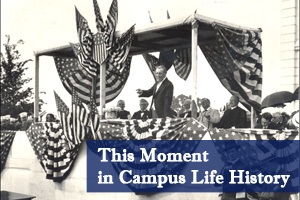Student Life
American University's Presidential Past & Present

As prefaced in the AU & the Myth of Tradition piece, the Office of Campus Life will now regularly feature news stories on the university’s past and its connection to the present. The “This Moment in Campus Life History” series will highlight outstanding features that tie the campus back to its historic beginnings.
This first piece – one of many to come – illustrates AU’s long tradition of presidential visits and speeches at the university. As this story will appear in two parts, be sure to check back in November for the second half and conclusion. Enjoy, and remember to follow @aucampuslife on Twitter for the latest news and updates from Campus Life’s eighteen departments.
American Vision
AU’s roots run deep down Pennsylvania Avenue.
Presidential ink endorsed the formation of the university, and presidents themselves laid the cornerstones of what would become The American University. From official visits and commencement speeches to quick laps around the track, AU has a storied tradition of ties with the country’s leader.
In 1891, Benjamin Harrison signed the Act of Congress that brought The American University into existence – a charter that still hangs in the office of the university president. Though it was Harrison’s pen that gave birth to the institution, President William McKinley championed the cause that such a university represented.
Marc Tomik, School of Public Affairs alum and graduate student, focused his Honors capstone on AU history. Combing the archives back to 1925, he dedicated months to capturing a vision of the university.
“McKinley was actually going to be our big guy. I’ve seen some documents saying that what Thomas Jefferson was to UVA, McKinley would have been to AU,” Tomik explains. “He really believed in the idea of having a national university, and he was a trustee member.”
McKinley even raised funds for what was intended to be the campus’ Ohio Building. His assassination led to AU’s first presidential visit in 1902, when Theodore Roosevelt laid the cornerstone of that very structure, renamed the McKinley Building.
Wearing his famous grin, Roosevelt told the crowd in attendance, “I would be glad to address you at any time, in any place. But I am doubly glad to address you here; and I most earnestly wish you well in your purpose to plant here a great American University – a university that shall fulfill the dream of the greatest and first American president, George Washington.”
To be fair, this wasn’t the first time presidential soles touched AU soil. Almost half a century earlier, Abraham Lincoln inspected Ft Gaines – a Civil War base that covered the ground where the campus would eventually stand. Of course, AU had yet to be imagined at that point. It seems fitting, though, that the land was first graced by the boots of a man committed to freedom and diplomacy – ideals that now define American University.
Roosevelt returned in 1908, followed by Woodrow Wilson on May 27, 1914, whose speech at the opening of the university inspired official AU symbols – the compass and the lodestar – that would last decades into the ‘60s.
Of the opening, he said, “So we are here setting up on this hill as upon a high pedestal once more the compass of human life with its great needle pointing at the lodestar of the human spirit. Let men who wish to know come and look upon this compass and thereafter determine the way they will go!”
This compass led students and presidents alike to continue coming to campus. In years that followed – as the university expanded – Warren Harding and Calvin Coolidge spoke at consecutive commencement ceremonies in 1921 and 1922. While Franklin D. Roosevelt never graced American, the student newspaper The Eagle reports various student visits to the White House at the invitation of the first family.
It wasn’t until 1957, however, that the next groundbreaking presidential visit occurred, when Dwight Eisenhower turned over soil that would cradle the growing School of International Service. A firm proponent of extending US efforts abroad, anecdotes credit Eisenhower for inspiring University President Hurst Robins Anderson to dedicate a new building and program to international service.
A shovel at his side, Eisenhower said, “So I come out this evening to congratulate American University on this great step…and to express my good wishes to all students who will enter that school to go into service of our country in the noblest work that our nation can possibly pursue, and that is the seeking of a peace based on justice.”
Moving earth aside for the future, Eisenhower carved out another piece of AU’s presidential history that continues to this day.
To read the second part of this series on AU's presidential connection from JFK to Barack Obama, click here.
Want more AU history? Follow @AUhistory for tweets on the university's colorful past.
